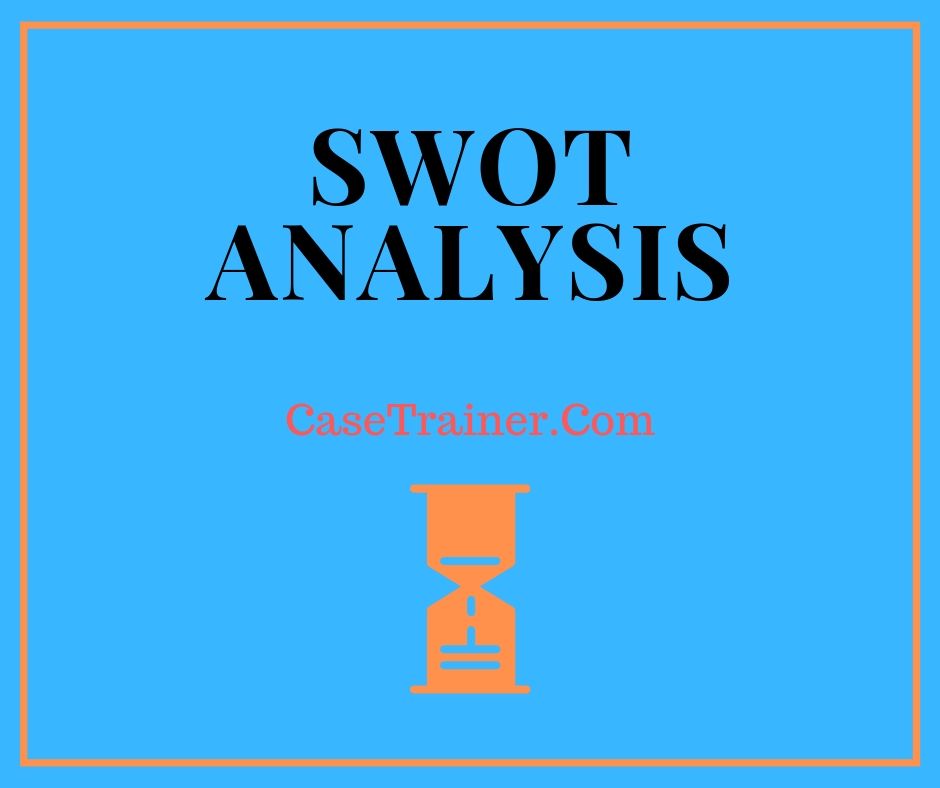Market Stretch Case Study Solution and Analysis
Introduction
Market Stretch is presently one of the most significant food chains worldwide. It was founded by Henri Market Stretch in 1866, a German Pharmacist who initially introduced "Farine Lactee"; a mix of flour and milk to feed babies and decrease death rate.
Market Stretch is now a global company. Unlike other international companies, it has senior executives from different nations and attempts to make decisions considering the whole world. Market Stretch Case Study Analysis currently has more than 500 factories around the world and a network spread across 86 countries.
Purpose
The function of Market Stretch Corporation is to improve the quality of life of individuals by playing its part and providing healthy food. It wishes to assist the world in shaping a healthy and better future for it. It also wants to encourage individuals to live a healthy life. While making certain that the company is succeeding in the long run, that's how it plays its part for a better and healthy future
Vision
Nestlé's vision is to offer its customers with food that is healthy, high in quality and safe to consume. Market Stretch pictures to establish a well-trained workforce which would help the company to grow.
Objective.
Nestlé's objective is that as currently, it is the leading business in the food market, it believes in 'Excellent Food, Great Life". Its mission is to offer its consumers with a range of choices that are healthy and finest in taste too. It is concentrated on offering the very best food to its customers throughout the day and night.
Products.

Market Stretch has a broad range of items that it offers to its clients. In 2011, Market Stretch was noted as the most rewarding company.
Goals and goals.
• Bearing in mind the vision and objective of the corporation, the company has laid down its objectives and goals. These objectives and goals are listed below.
• One goal of the business is to reach absolutely no garbage dump status.
• Another objective of Market Stretch is to waste minimum food during production. Frequently, the food produced is lost even prior to it reaches the consumers.
• Another thing that Market Stretch is dealing with is to enhance its product packaging in such a method that it would help it to lower the above-mentioned complications and would also ensure the shipment of high quality of its products to its customers.
• Meet global requirements of the environment.
• Build a relationship based on trust with its customers, business partners, workers, and federal government.
Crucial Problems.
Recently, Market Stretch Company is focusing more towards the strategy of NHW and investing more of its revenues on the R&D innovation. The nation is investing more on mergers and acquisitions to support its NHW method. The target of the company is not achieved as the sales were anticipated to grow greater at the rate of 10% per year and the operating margins to increase by 20%, provided in Exhibition H. There is a requirement to focus more on the sales then the innovation technology. Otherwise, it might lead to the declined profits rate. (Henderson, 2012).
Situational Analysis.

Analysis of Existing Strategy, Vision and Goals.
The existing Market Stretch technique is based upon the idea of Nutritious, Health and Wellness (NHW). This method deals with the idea to bringing change in the client choices about food and making the food things much healthier worrying about the health concerns.
The vision of this method is based upon the secret approach i.e. 60/40+ which merely means that the items will have a rating of 60% on the basis of taste and 40% is based upon its nutritional value. The items will be made with extra dietary value in contrast to all other products in market getting it a plus on its nutritional content.
This method was embraced to bring more delicious plus healthy foods and beverages in market than ever. In competitors with other companies, with an intention of maintaining its trust over customers as Market Stretch Business has actually acquired more relied on by customers.
Microenvironment Analysis (PESTEL Analysis).
The analysis used to determine the position of business in the market is done by using PESTLE analysis, given up Exhibit A. Market Stretch works under the regulations and rules directed by federal government and food authority. The company is more focused on its services and items to make certain about the product quality and safety. This analysis will help in understanding environment of external market in the worldwide food and drink industries. (Parera, 2017).
Political.

The political influence on the business is greatly influenced by the government laws and policies. The company has to fulfill its requirements supplied by government otherwise it needs to pay fine. Market Stretch is significantly supported by Government to meet all the requirements of requirements like acts of health and safety. In efforts to make great food, Market Stretch is changing the requirements of food and beverage production. This may cause the offense of governmental guidelines and policies.
Economic.
Initiation of the business where the capital income of each private matters for the increased net sale as this differs country-to-country. The economy of the Market Stretch Company in U.S. is growing year by year with variable items launch specifically focusing on the dietary food for infants.
Social.
The social environment keeps changing with respect to time like the mindset of the consumer as well as their way of lives. Any product and services of any business can not achieve success until the company is not worried about the living system of the customer. Market Stretch is taking procedures to satisfy its goals as the world is in search of healthy and yummy food.
Technological.
In the development of business, tactical steps are somewhat obligatory. Market Stretch is one of the leading famous multinational firm and by time it invests in different departments to take its products to brand-new level. Market Stretch is investing more on its R&D to make its items healthier and healthy offering consumers with health benefits.
Legal.
There is no such impact of legal factors of Market Stretch as it is more concerned over its regulations and laws.
Environmental
Market Stretch, in terms of ecological effect is dedicated to work in eco-friendly environment with preservation of the natural resources and energy. If the resources used are recyclable or not, as due to the manufacturing of bigger number of items there might be a danger.
Competitive Forces Analysis (Porter's Five Forces Design).
Market Stretch Case Study Solution has actually gotten a variety of business that helped it in diversification and development of its item's profile. This is the thorough description of the Porter's model of five forces of Market Stretch Company, given up Exhibition B.
Competitiveness.
Market Stretch is one of the top business in this competitive industry with a number of strong competitors like Unilever, Kraft foods and Group DANONE. Market Stretch is running well in this race for last 150 years. The competitors of other companies with Market Stretch is quite high.

Threat of New Entrants.
A number of barriers are there for the brand-new entrants to take place in the customer food market. Just a few entrants be successful in this market as there is a requirement to understand the consumer need which requires time while recent competitors are well aware and has advanced with the customer loyalty over their items with time. There is low hazard of new entrants to Market Stretch as it has quite big network of circulation worldwide controling with well-reputed image.
Bargaining Power of Suppliers.
In the food and beverage industry, Market Stretch Case Study Help owes the largest share of market requiring higher number of supply chains. In action, Market Stretch has also been concerned for its providers as it thinks in long-lasting relations.
Bargaining Power of Purchasers.
There is high bargaining power of the purchasers due to fantastic competition. Switching cost is quite low for the consumers as many companies sale a number of comparable products. This seems to be a terrific hazard for any company. Therefore, Market Stretch Case Study Solution ensures to keep its clients pleased. This has led Market Stretch to be one of the devoted company in eyes of its buyers.
Threat of Alternatives.
There has been a fantastic threat of alternatives as there are replacements of some of the Nestlé's items such as boiled water and pasteurized milk. There has actually also been a claim that some of its products are not safe to use resulting in the decreased sale. Thus, Market Stretch began highlighting the health benefits of its items to cope up with the replacements.
Competitor Analysis.
Market Stretch Case Study Help covers a lot of the popular customer brand names like Package Kat and Nescafe and so on. About 29 brands among all of its brand names, each brand name earned an earnings of about $1billion in 2010. Its major part of sale remains in North America constituting about 42% of its all sales. In Europe and U.S. the leading major brand names offered by Market Stretch in these states have an excellent trustworthy share of market. Similarly Market Stretch, Unilever and DANONE are two big markets of food and drinks as well as its primary competitors. In the year 2010, Market Stretch had actually earned its yearly profit by 26% increase due to the fact that of its increased food and drinks sale particularly in cooking things, ice-cream, drinks based on tea, and frozen food. On the other hand, DANONE, due to the increasing prices of shares resulting a boost of 38% in its earnings. Market Stretch Case Study Analysis decreased its sales cost by the adaptation of a new accounting treatment. Unilever has number of employees about 230,000 and functions in more than 160 countries and its London headquarter. It has actually become the second biggest food and beverage market in the West Europe with a market share of about 8.6% with just a difference of 0.3 points with Market Stretch. Unilever shares a market share of about 7.7 with Market Stretch ending up being first and ranking DANONE as third. Market Stretch attracts local customers by its low cost of the product with the local taste of the items keeping its first place in the international market. Market Stretch company has about 280,000 employees and functions in more than 197 countries edging its competitors in numerous areas. Market Stretch has actually also minimized its expense of supply by presenting E-marketing in contrast to its rivals.
Note: A brief comparison of Market Stretch with its close competitors is given in Display C.
SWOT Analysis.
The internal analysis and external of the business also can be done through SWOT Analysis, summed up in the Exhibition F.
Strengths.
• Market Stretch has an experience of about 140 years, enabling company to much better perform, in different circumstances.
• Nestlé's has presence in about 86 nations, making it a worldwide leader in Food and Beverage Industry.
• Market Stretch has more than 2000 brands, which increase the circle of its target customers. These brands consist of child foods, animal food, confectionary products, drinks and so on. Famous brands of Market Stretch consist of; Maggi, Kit-Kat, Nescafe, and so on
• Market Stretch Case Study Solution has large amount of costs on R&D as compare to its rivals, making the company to release more nutritious and innovative products. This development offers the business a high competitive position in long term.
• After embracing its NHW Method, the business has actually done large quantity of mergers and acquisitions which increase the sales growth and enhance market position of Market Stretch.
• Market Stretch is a popular brand with high customer's loyalty and brand recall. This brand name loyalty of consumers increases the possibilities of easy market adoption of various new brands of Market Stretch.
Weaknesses.
• Acquisitions of those business, like; Kraft frozen Pizza organisation can offer an unfavorable signal to Market Stretch customers about their compromise over their core proficiency of healthier foods.
• The development I sales as compare to the company's investment in NHW Method are rather different. It will take long to alter the understanding of people ab out Market Stretch as a company offering nutritious and healthy items.
Opportunities.
• Presenting more health related items allows the company to catch the marketplace in which consumers are rather mindful about health.
• Developing nations like India and China has biggest markets in the world. Thus broadening the market towards developing nations can improve the Market Stretch company by increasing sales volume.
• Continue acquisitions and joint ventures increases the market share of the company.
• Increased relationships with schools, hotel chains, dining establishments and so on can also increase the number of Market Stretch Case Study Help consumers. Teachers can advise their students to buy Market Stretch items.
Risks.
• Financial instability in countries, which are the potential markets for Market Stretch, can develop numerous issues for Market Stretch.
• Shifting of products from typical to healthier, causes additional costs and can result in decrease business's earnings margins.
• As Market Stretch has a complex supply chain, for that reason failure of any of the level of supply chain can lead the company to face particular issues.
Segmentation Analysis
Demographic Division
The group segmentation of Market Stretch Case Study Solution is based on four aspects; age, earnings, gender and occupation. For instance, Market Stretch produces a number of products associated with infants i.e. Cerelac, Nido, etc. and related to adults i.e. confectionary items. Market Stretch products are rather inexpensive by almost all levels, however its significant targeted consumers, in regards to income level are upper and middle middle level clients.
Geographical Segmentation
Geographical segmentation of Market Stretch Case Study Help is made up of its existence in nearly 86 nations. Its geographical segmentation is based upon 2 primary elements i.e. average income level of the consumer as well as the climate of the area. For example, Singapore Market Stretch Business's division is done on the basis of the weather condition of the region i.e. hot, cold or warm.
Psychographic Segmentation
Psychographic division of Market Stretch is based upon the personality and lifestyle of the consumer. For example, Market Stretch 3 in 1 Coffee target those customers whose lifestyle is rather hectic and do not have much time.
Behavioral Segmentation
Market Stretch Case Solution behavioral segmentation is based upon the mindset knowledge and awareness of the customer. Its highly healthy items target those consumers who have a health conscious attitude towards their intakes.
VRIO Analysis
The VRIO analysis of Market Stretch Business is a broad variety analysis supplying the organization with an opportunity to get a viable competitive benefit versus its competitors in the food and drink market, summed up in Exhibition I.
Valuable
The resources utilized by the Market Stretch company are important for the company or not. Such as the resources like financing, personnels, management of operations and experts in marketing. This are a few of the crucial important factors of for the identification of competitive benefit.
Uncommon
The important resources made use of by Market Stretch are costly or even unusual. , if these resources are commonly discovered that it would be easier for the competitors and the new competitors in the market to effortlessly move in competition.
Replica
The imitation procedure is costly for the competitors of Market Stretch Case Solution Business. However, it can be done just in two different techniques i.e. product duplication which is produced and manufactured by Market Stretch Business and launching of the substitute of the items with changing cost. This increases the danger of interruption to the current structure of the industry.
Company
This element of VRIO analysis deals with the compatibility of the business to place in the market making efficient use of its valuable resources which are difficult to mimic. Regularly, the development of management is totally based on the firm's execution strategy and team. Thus, this polishes the skills of the company by time based upon the choices made by company for the progression of its strategic capitals.
Quantitative Analysis
R&D Spending as a portion of sales are declining with increasing actual amount of spending reveals that the sales are increasing at a greater rate than its R&D costs, and allow the company to more invest in R&D.
Net Earnings Margin is increasing while R&D as a percentage of sales is decreasing. This indication likewise shows a green light to the R&D spending, acquisitions and mergers.
Financial obligation ratio of the company is increasing due to its spending on mergers, acquisitions and R&D development instead of payment of financial obligations. This increasing financial obligation ratio posture a threat of default of Market Stretch to its investors and could lead a decreasing share rates. For that reason, in terms of increasing debt ratio, the company ought to not spend much on R&D and needs to pay its current financial obligations to reduce the threat for financiers.
The increasing danger of financiers with increasing debt ratio and decreasing share costs can be observed by substantial decrease of EPS of Market Stretch Case Analysis stocks.
The sales development of business is also low as compare to its acquisitions and mergers due to slow perception building of customers. This slow development likewise hinder business to further invest in its mergers and acquisitions.( Market Stretch, Market Stretch Financial Reports, 2006-2010).
Keep in mind: All the above analysis is done on the basis of computations and Graphs given in the Exhibits D and E.
TWOS Analysis.
TWOS analysis can be utilized to derive different techniques based upon the SWOT Analysis given above. A brief summary of TWOS Analysis is given in Exhibit H.
Techniques to exploit Opportunities utilizing Strengths.
Market Stretch Case Analysis ought to introduce more ingenious products by big amount of R&D Spending and acquisitions and mergers. It could increase the market share of Market Stretch and increase the earnings margins for the company. It might also supply Market Stretch a long term competitive advantage over its competitors.
The worldwide expansion of Market Stretch need to be concentrated on market recording of developing countries by expansion, drawing in more consumers through customer's loyalty. As developing nations are more populous than developed countries, it could increase the consumer circle of Market Stretch.
Strategies to Conquer Weak Points to Make Use Of Opportunities.
Market Stretch Case Help should do cautious acquisition and merger of organizations, as it could impact the customer's and society's understandings about Market Stretch. It must combine and get with those business which have a market track record of healthy and nutritious business. It would enhance the understandings of customers about Market Stretch.
Market Stretch should not just invest its R&D on development, rather than it should also focus on the R&D costs over evaluation of cost of different healthy products. This would increase expense efficiency of its products, which will lead to increasing its sales, due to decreasing rates, and margins.
Techniques to utilize strengths to overcome hazards.
Market Stretch Case Analysis must move to not only developing however also to developed countries. It ought to broadens its geographical growth. This wide geographical expansion towards establishing and established countries would reduce the threat of potential losses in times of instability in numerous countries. It needs to expand its circle to numerous nations like Unilever which runs in about 170 plus nations.
Strategies to conquer weaknesses to avoid hazards.
Market Stretch ought to wisely manage its acquisitions to prevent the risk of misunderstanding from the consumers about Market Stretch. It must acquire and merge with those nations having a goodwill of being a healthy company in the market. This would not just improve the understanding of consumers about Market Stretch however would likewise increase the sales, revenue margins and market share of Market Stretch. It would likewise enable the company to utilize its potential resources effectively on its other operations instead of acquisitions of those companies slowing the NHW technique development.
Alternatives.
In order to sustain the brand name in the market and keep the customer intact with the brand, there are 2 alternatives:.
Option: 1.
The Business must spend more on acquisitions than on the R&D.
Pros:.
1. Acquisitions would increase total assets of the business, increasing the wealth of the business. Nevertheless, costs on R&D would be sunk cost.
2. The business can resell the gotten systems in the market, if it stops working to execute its strategy. Amount spend on the R&D could not be restored, and it will be considered entirely sunk expense, if it do not give possible outcomes.
3. Spending on R&D supply slow growth in sales, as it takes very long time to introduce a product. Acquisitions supply quick results, as it offer the company currently developed item, which can be marketed quickly after the acquisition.
Cons:.
1. Acquisition of company's which do not fit with the company's worths like Kraftz foods can lead the company to deal with misunderstanding of customers about Market Stretch core worths of healthy and healthy products.
2. Big costs on acquisitions than R&D would send a signal of business's ineffectiveness of developing innovative items, and would results in consumer's frustration also.
3. Large acquisitions than R&D would extend the line of product of the business by the products which are currently present in the market, making business unable to present new ingenious items.
Option: 2
The Company must invest more on its R&D instead of acquisitions.
Pros:
1. It would make it possible for the company to produce more ingenious products.
2. It would supply the business a strong competitive position in the market.
3. It would make it possible for the business to increase its targeted customers by introducing those items which can be used to a totally brand-new market sector.
4. Ingenious items will provide long term benefits and high market share in long run.
Cons:
1. It would reduce the earnings margins of the company.
2. In case of failure, the entire costs on R&D would be thought about as sunk expense, and would impact the business at big. The danger is not in the case of acquisitions.
3. It would not increase the wealth of company, which could supply an unfavorable signal to the investors, and could result I decreasing stock rates.
Alternative 3:
Continue its acquisitions and mergers with substantial spending on in R&D Program.
Pros:
1. It would allow the company to present brand-new innovative products with less risk of transforming the costs on R&D into sunk cost.
2. It would provide a positive signal to the investors, as the overall possessions of the company would increase with its substantial R&D spending.
3. It would not affect the earnings margins of the company at a big rate as compare to alternative 2.
4. It would supply the company a strong long term market position in terms of the business's total wealth as well as in regards to ingenious items.
Cons:
1. Risk of conversion of R&D costs into sunk expense, higher than alternative 1 lesser than alternative 2.
2. Threat of mistaken belief about the acquisitions, higher than alternative 2 and lesser than alternative 1.
3. Introduction of less variety of ingenious products than alternative 2 and high variety of ingenious products than alternative 1.
Suggestion
With the deep analysis of the above options, it is recommended that the company must select the alternative 3 in order to maintain a competitive position in the long run. As the alternative 3 would enable the company to not only introduce new and ingenious products in the market it would likewise reduce the high expenditures on R&D under alternative 2 and increase the revenue margins. It would enable the business to increase its share costs also, as financiers want to invest more in companies with substantial R&D costs and boost in the total worth of the business.
Action and implementation Strategy
Technique can be carried out efficiently by establishing specific short-term in addition to long term plans. These plans might be as follows;
Short Term Strategy (0-1 year).
• Under the short-term strategy Market Stretch Case Solution need to perform numerous activities to execute its NHW strategy efficiently. These activities are as follows;.
• Get the audit of its brand name portfolio done, to examine the core selling brand names, which create the majority of its revenue.
• Examine the present target market along with the marketplace segment which is not include in the business's circle.
• Evaluate the current monetary data to measure the amount that needs to be invested in the R&D and acquisitions.
• Evaluate the potential investors and their nature, i.e. do they want long term benefits (capital gain), or the want early profits (dividend). It would let the company to understand that how much quantity must be spent on R&D.
Mid Term Strategy (1-5 years).
• Get those companies in which the company has possible experience to handle. Acquire most beneficial organizations with a strong dedication to health, to construct the customer's understandings in the ideal instructions.
• Focus more on acquisitions than R&D to construct the base in the customer's mind about Market Stretch values and vision and to avoid potential risk of sunk expense.
Long Term Plan (1-10 years).
• Get companies with health along with taste factor, as the base for the Market Stretch as a company producing healthy items has actually been built under midterm strategy and now the company could move towards taste element too to understand the consumers, which focus more on taste rather than health.
• Be more aggressive towards R&D than the acquisitions, as it is the considerable time to develop new products.
Conclusion.

Market Stretch has stayed the leading market gamer for more than a decade. It has actually institutionalized its strategies and culture to align itself with the market modifications and consumer habits, which has ultimately permitted it to sustain its market share. Market Stretch has actually established significant market share and brand name identity in the urban markets, it is recommended that the business ought to focus on the rural locations in terms of developing brand name awareness, equity, and commitment, such can be done by creating a specific brand name allocation strategy through trade marketing methods, that draw clear distinction between Market Stretch items and other competitor items. Market Stretch ought to take advantage of its brand name image of safe and healthy food in catering the rural markets and likewise to upscale the offerings in other classifications such as nutrition. This will permit the company to establish brand name equity for freshly introduced and currently produced products on a higher platform, making the effective use of resources and brand image in the market.

